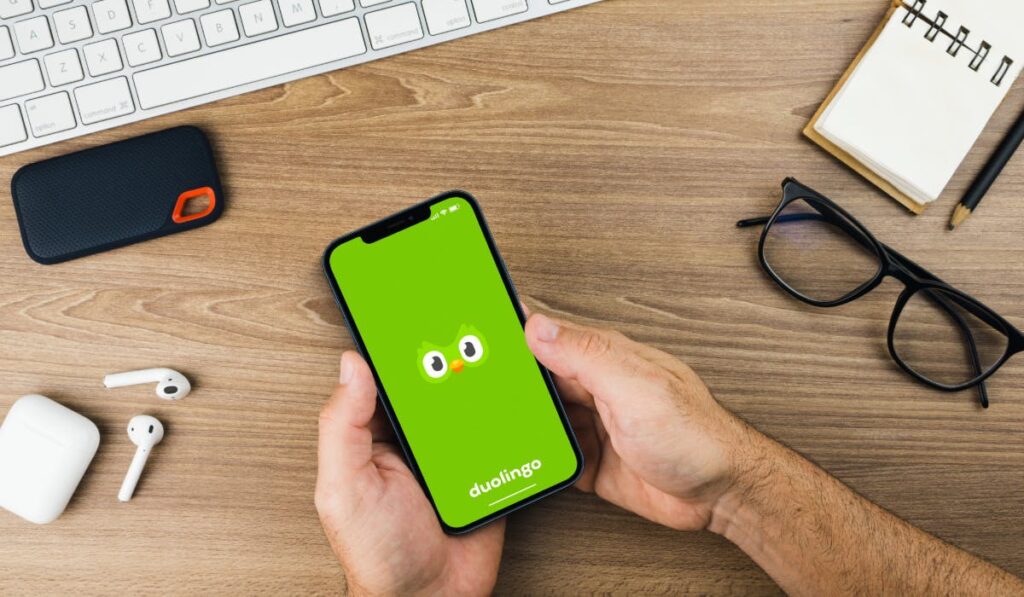
Duolingo’s “unhinged” approach to its viral marketing has worked to “inspire” the rest of the organisation and enabled marketing to have more influence across the organisation, says the firm’s CMO.
Renowned for its success on social media, in particular TikTok, Duolingo’s owl brand mascot Duo has been brought to life using dark humour and cultural references.
Speaking at the Cannes Lion Festival of Creativity today (16 June), Duolingo CMO Emmanuel Orssaud noted that, historically, there has been some separation between marketing and product within the business. That was probably most noticeable in how Duo was used in communications on social and through advertising, versus how the owl appeared on the app.
 Duolingo’s “unhinged” approach to its viral marketing has worked to “inspire” the rest of the organisation and enabled marketing to have more influence across the organisation, says the firm’s CMO.
Duolingo’s “unhinged” approach to its viral marketing has worked to “inspire” the rest of the organisation and enabled marketing to have more influence across the organisation, says the firm’s CMO.
Renowned for its success on social media, in particular TikTok, Duolingo’s owl brand mascot Duo has been brought to life using dark humour and cultural references.
Speaking at the Cannes Lions Festival of Creativity today (16 June), Duolingo CMO Emmanuel Orssaud noted that, historically, there has been some separation between marketing and product within the business. That was probably most noticeable in how Duo was used in communications on social and through advertising, versus how the owl appeared on the app.
Orssaud described the use of Duo on social channels as “unhinged”. A notable recent example was content created when Duolingo “killed” the owl, which included holding fake funerals and announcing Duo was killed by a Tesla Cybertruck. By contrast, how the owl has appeared in the app has traditionally been “wholesome”, seen as an encouraging mascot to inspire language learners.
‘The triple win’: Why marketers have an ‘essential seat’ in the NPD process
While far from conventional, that “unhinged” approach has proved popular with audiences and gained the brand plenty of attention.
For example, Orssaud said the death announcement, which happened the Monday after Super Bowl Sunday (9 February) and only cost the brand a few thousand dollars, gained twice as much user-generated content as some of the best-performing Super Bowl ads.
That sort of success has worked to “inspire” the rest of the organisation.
“Now what you start to see is […] that some of those unhinged elements are flowing into our product,” he says, explaining this is because marketing has been able to prove this approach works.
This success is enabling marketing to have more of a seat at the table in other discussions and influence product in particular.
“It is not uncommon for marketing to work with product to help shape new features and new products directly,” he says. “We have earned a seat a table through this approach.”
Permission from failure
For those only recently acquainted with Duolingo, it might be easy to think the firm has always been a social-first creative brand, born with viral marketing in its blood. However, this is far from the case and six years ago its approach to communications and advertising looked very different.
Orssaud explained that, because of its success, outsiders tend to assume Duolingo has huge budgets. However, the brand’s marketing spend as a percentage only hovers around 6% (the average figure for 2025 was 7.7%, according to Gartner). The marketing function also has a fairly lean team, with only 48 members across the global business.
It’s not been scale that has made Duolingo the viral success it is today. Indeed, the company’s unorthodox approach to marketing was born out of a need for a more creative use of small budgets.
Going back five or six years, Duolingo’s communications focus was big above-the-line campaigns, carrying product-oriented messages about why people should use the app.
The problems of these sorts of campaigns were threefold. Firstly, they were expensive. With only around a tenth of Duolingo’s users paying for a subscription, spending a lot on a big campaign was hard to justify, Orssaud said.
“The second problem is that those campaigns were not optimised towards either awareness in building the brand or driving quality,” he said. “Because we were spending a lot of money, we were saying to ourselves: ‘Hey, let’s do everything.’”
The effectiveness of these ads suffered as a result.
The third problem was that Duolingo’s previous approach to advertising was not driving people to talk about the brand, Orssaud noted.
The “failure” of the brand’s previous approach, gave it the permission to try something new, focusing on virality and earned media as key goals for the marketing organisation.
The role of experimentation
Duolingo knew big above-the-line campaigns were not working for the brand and wanted to focus on driving earned media. However, it still had to decide which approach to take.
The brand took cues from its own audience. Sparked by the persistent notifications Duolingo sends its users to remind them to complete a lesson, the brand had long parodied the Duo mascot, animating him in a sinister way, for example, holding a knife and threatening users to complete their sessions.
“That does sound like a PR nightmare, but as a brand, we didn’t actually try to defend ourselves or push back,” he said. “We decided to lean into this and we decided to go with that dark humour that our community was already enjoying out there.”
In terms of how Duolingo brings that to life, Orssaud highlighted the role of experimentation in the business. The brand prides itself on being agile and culturally attuned to the world, but in order to keep being that way experimentation is essential.
The brand spends 70% of its budget on things it knows works well for Duolingo and are proven successes, and the other 30% on experimentation.
“When something works, we scale it, we find ways to actually double down and make it bigger,” Orssaud explained.


